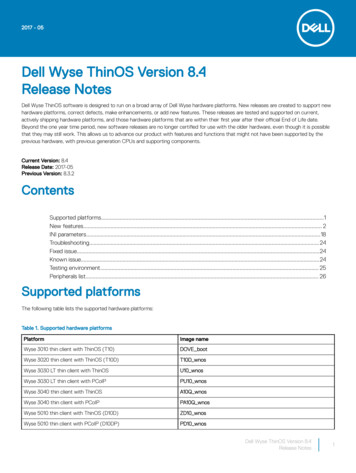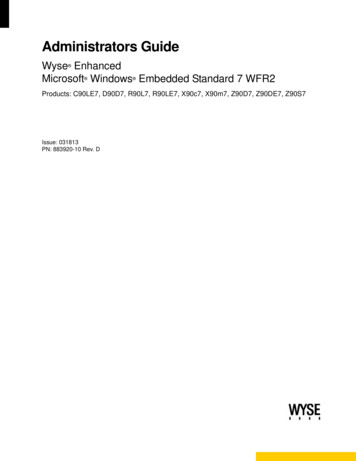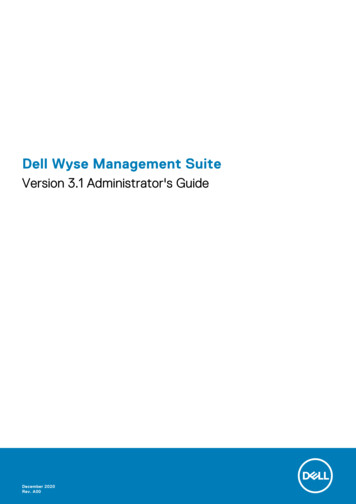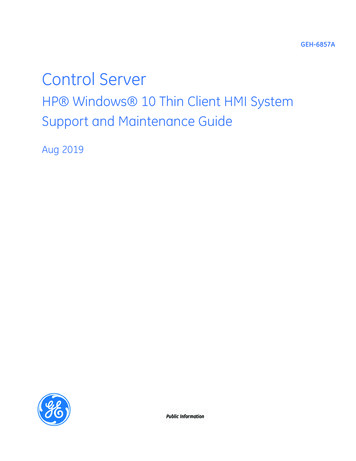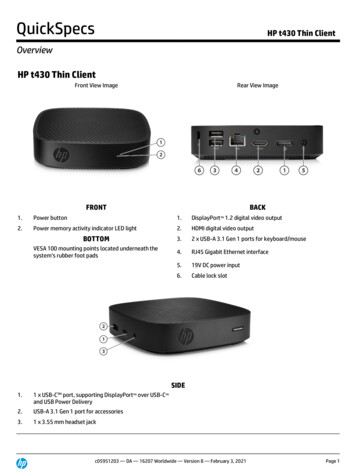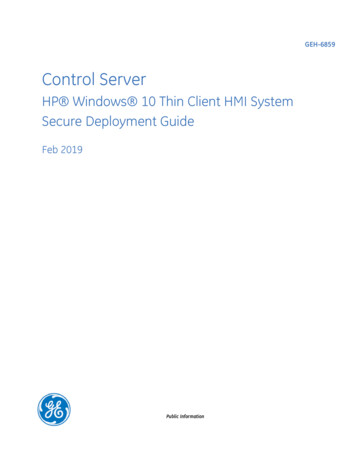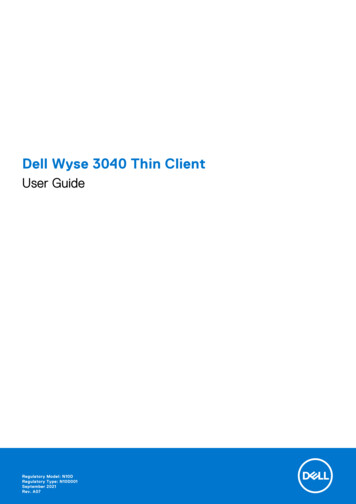
Transcription
Dell Wyse 3040 Thin ClientUser GuideRegulatory Model: N10DRegulatory Type: N10D001September 2021Rev. A07
Notes, cautions, and warningsNOTE: A NOTE indicates important information that helps you make better use of your product.CAUTION: A CAUTION indicates either potential damage to hardware or loss of data and tells you how to avoidthe problem.WARNING: A WARNING indicates a potential for property damage, personal injury, or death. 2018-2021 Dell Inc. or its subsidiaries. All rights reserved. Dell, EMC, and other trademarks are trademarks of Dell Inc. or its subsidiaries.Other trademarks may be trademarks of their respective owners.
ContentsChapter 1: Welcome to Dell Wyse 3040 thin client. 5About this guide. 5Dell Wyse external references.5Chapter 2: Wyse 3040 thin client hardware installation. 6Chapter 3: Wyse 3040 thin client on ThinOS.7Logging on to the Wyse 3040 thin client running Wyse ThinOS. 7Configuring the dual head display settings in Dell Wyse ThinOS. 7Configuring the network settings on Dell Wyse ThinOS.9Configuring the General settings. 9Configuring the DHCP options settings. 11Configuring the ENET settings.11Configuring the WLAN settings.13Configuring peripherals settings on Wyse ThinOS.13Configuring keyboard settings. 13Configuring mouse settings. 14Configuring camera settings.14Configuring the printer settings. 15Power state. 24Configuring the broker setup on Dell Wyse ThinOS. 24Configuring the WDA settings on Dell Wyse ThinOS. 26Chapter 4: Wyse 3040 thin client on ThinLinux. 29Accessing thin client BIOS settings on Wyse ThinLinux.29Logging on to the Wyse 3040 thin client running ThinLinux. 29Configuring display on Dell Wyse ThinLinux. 30Configuring the network settings on Dell WyseThinLinux. 30Configuring the wi-fi settings. 31Configuring wired network connection settings. 33Configuring the network proxy settings. 35Adding a network connection.36Configuring peripherals settings on Wyse ThinLinux.38Setting the keyboard preferences.38Setting the mouse preferences. 39Configuring the printer settings. 40Configuring the sound settings.41Power state. 43Configuring connections locally on Dell Wyse ThinLinux. 43Configuring and managing Citrix connections.43Configuring and managing VMware connections. 44Configuring WDA settings on Dell Wyse ThinLinux.47Chapter 5: Major components of your system. 50Contents3
Chapter 6: Removing and installing components. 51Before working on your thin client.51After working on your thin client. 51Safety Precautions. 51Recommended tools. 57Disassembly and Reassembly. 57Chassis cover removal.57WLAN card removal.58Printed Circuit Board Assembly removal. 59Coin Battery removal.60Heat sink or Thermal module disassembly. 61EMI Gasket.62Chapter 7: System specifications. 65Chapter 8: Thermal management on Wyse 3040 thin client . 67Chapter 9: BIOS overview. 68Accessing thin client BIOS settings. 68System Setup overview.68Boot Sequence.69Navigation keys.69General screen options. 69System Configuration screen options. 70Security screen options. 70Secure Boot screen options. 71Performance screen options.72Power Management screen options. 72POST Behavior screen options. 73Virtualization support screen options. 73Maintenance screen options.73System Log screen options.74Updating the BIOS . 74Chapter 10: Troubleshooting your system.75Power states and LED behavior . 75Diagnostic power LED codes.75Power LED error code behavior.764Contents
1Welcome to Dell Wyse 3040 thin clientDell Wyse 3040 thin client is a low-cost entry level thin client platform. These thin clients have a x86 processor, which allowsyou to run Wyse ThinOS, PCoIP enabled Wyse ThinOS, and Wyse ThinLinux. The platform is used as a thin client by connectingto any monitor and allows you to use a remote access client for VDI or cloud-based computing.Topics: About this guideDell Wyse external referencesAbout this guideThis guide is intended for Wyse 3040 thin clients which run Wyse ThinOS, PCoIP enabled Wyse ThinOS, and Wyse ThinLinux. Itprovides hardware specifications and OS-specific configurations to help you work with Wyse 3040 thin clients.Dell Wyse external referencesThis section provides links to Dell support sites for Dell Wyse thin clients. Dell reference guides — Information about the products with required documentation. Dell Service and Support — Latest software images Dell Wyse Device Manager — Information about Dell remote management software Dell and the Environment — Information about Dell compliance with RoHS and with the Waste Electrical and ElectronicEquipment (WEEE) Dell and e-Recycling — Information about recycling and reuse of Dell products Dell Warranty Registration — Register your productWelcome to Dell Wyse 3040 thin client5
2Wyse 3040 thin client hardware installationFor more information on the hardware installation, see Dell Wyse 3040 thin client Quick Start Guide .6Wyse 3040 thin client hardware installation
3Wyse 3040 thin client on ThinOSThis section provides the instructions on how to easily configure and efficiently manage Wyse 3040 thin client that runs onThinOS.Topics: Logging on to the Wyse 3040 thin client running Wyse ThinOSConfiguring the dual head display settings in Dell Wyse ThinOSConfiguring the network settings on Dell Wyse ThinOSConfiguring peripherals settings on Wyse ThinOSPower stateConfiguring the broker setup on Dell Wyse ThinOSConfiguring the WDA settings on Dell Wyse ThinOSLogging on to the Wyse 3040 thin client running WyseThinOSWhat you see after logging on to the server depends on the administrator configurations. Users with a Classic Desktop - will see the classic ThinOS desktop with full taskbar, desktop, and Connect Managerfamiliar to ThinOS users. This option is the default out-of-the-box experience and is recommended for terminal serverenvironments with published applications and for backward compatibility with ThinOS 6.x versions. Users with a Zero Desktop - will see the Zero Desktop with the Zero Toolbar showing the assigned list of connectionsfrom which to select. This option is recommended for VDI and any full-screen only connections.In any desktop case, you can select the desktop option you want (Classic Desktop or Zero Desktop) and create the connectionsyou need using the Visual Experience tab on the Remote Connections dialog box.To open the Remote Connections dialog box, perform one of the following tasks: Classic Desktop — Click User Name , and then select System Setup Remote Connections.NOTE: User Name is the user who is logged-on and is located at the lower-left pane of the taskbar Zero Desktop — Click the System Settings icon on the Zero Toolbar, and then select Remote Connections.Configuring the dual head display settings in DellWyse ThinOSTo configure the dual head display settings in Wyse ThinOS:1. From the desktop menu, click System Setup, and then click Display.The Display dialog box is displayed.2. Click the Dual Head tab, and use the following guidelines:Wyse 3040 thin client on ThinOS7
This feature is applicable for supported dual-monitor-capable thin clients only.a. Dual Head—Select Mirror Mode to have the two monitors work in a matching state, or Span Mode to have the twomonitors work individually.b. Main Screen—Select which of the two monitors you want to be the main screen (Screen1 or Screen2). The otherscreen is extended from the main screen.c. Layout—Select how you want the two monitors to be oriented to each other.Horizontal — where you move between the monitors from the left and right of the screens.Vertical— where you move between the monitors from the top and bottom of the screens.d. Alignment— Select how you want the monitors to be aligned Bottom, Center, or Top.Bottom means screens are bottom-aligned in a horizontal orientation; Center means screens are center-aligned; Topmeans screens are top-aligned in a horizontal orientation.e. Taskbar (Classic Desktop Only)—Select under which screen you want the taskbar to appear Whole Screen or MainScreenGamma Supported Monitors Only— Use the Gamma Setup tab to adjust the saturation values for Red, Green andBlue on VGA connected monitors supporting gamma settings, if you feel the default settings are too light. Be aware thatthe Gamma Setup tab will be disabled once you click Save Exit. You can enable it again by setting rgamma {1-100}ggamma {1-100} bgamma {1-100} in the Resolution INI parameter. For more information, see Dell Wyse ThinOS INIGuide.8Wyse 3040 thin client on ThinOS
For Swap dual screens, when you set Main Screen to Screen2, an additional check box is displayed at the bottom of thetab that allows you to swap dual screens. If you clear the check box, the Screen1 is usually the left one or the top onein dual display. When you set Main Screen to Screen2, the main screen is changed to the right screen or bottom screen.If you select the Swap dual screens check box, you are able to set Main Screen to Screen2, but still have it at the leftside or the top side, which is considered more user friendly.Configuring the network settings on Dell WyseThinOSTo configure the network settings use the following options:Configuring the general settings.Configuring the DHCP options settings.Configuring the ENET settings.Configuring the WLAN settings.Configuring the General settingsTo configure the general network settings:Wyse 3040 thin client on ThinOS9
1. From the desktop menu, click System Setup, and then click Network Setup.The Network Setup dialog box is displayed.2. Click the General tab, and use the following guidelines:a. To set the default gateway, select the type of network interface from the available options.i.Single Network support — Either wireless or wired network is connected. ENET — Click this option, if you want set up the Ethernet Wired Network Connection. WLAN — Click this option, if you want to set up the Wireless Network Connection. If you use wireless network after selecting ENET connection or wired network after selecting WLAN connection,then the system log "WLAN: set default gate way xxx.xxx.xxx.xxx" for first case and "ENET: set default gate wayxxx.xxx.xxx.xxx" for second case are printed to ensure that the UI setting reflects the actual usage.NOTE: The User Interface (UI) will not be changed automatically.ii. Dual Network support — Both wireless and wired networks are connected. The default gateway is determined bythe UI settings.b. Enter the URL address of the DNS domain in the DNS Domain box.c. Enter the IP address of the DNS server in the DNS Server box.Use of DNS is optional. DNS allows you to specify remote systems by their host names rather than IP addresses. If aspecific IP address (instead of a name) is entered for a connection, it is used to make the connection. Enter the DNSdomain and the network address of an available DNS server. The function of the DNS domain entry is to provide a defaultsuffix to be used in name resolution. The values for these two boxes may be supplied by a DHCP server. If the DHCPserver supplies these values, they replace any locally configured values. If the DHCP server does not supply these values,the locally configured values will be used.10Wyse 3040 thin client on ThinOS
NOTE: You can enter up to 16 DNS server addresses, separated by a semicolon, comma, or space. The first addressis for the primary DNS server and the rest are secondary DNS servers or backup DNS servers .d. Enter the IP address of the WINS server in the WINS Server box.Use of WINS is optional. Enter the network address of an available WINS name server. WINS allows you to specifyremote systems by their host names rather than IP addresses. If a specific IP address (instead of a name) is enteredfor a connection, it is used to make the connection. These entries can be supplied through DHCP, if DHCP is used. DNSand WINS provide essentially the same function, name resolution. If both DNS and WINS are available, the thin clientattempts to resolve the name using DNS first and then WINS.You can enter two WINS server addresses (primary and secondary), separated by a semicolon, comma, or space.e. Enter the digit multiplier of 30 seconds in the TCP Timeout box to set the time-out value of a TCP connection. Thevalue must be 1 or 2 which means the connection time-out value is from 1x30 30 seconds to 2x30 60 seconds. Ifthe data for connecting to the server is not acknowledged and the connection is timed out, setting the time-out periodretransmits the sent data and again tries to connect to the server till the connection is established.3. Click OK to save the settings.Configuring the DHCP options settingsTo configure the options settings:1. From the desktop menu, click System Setup, and then click Network Setup.The Network Setup dialog box is displayed.2. Click the Options tab, and use the following guidelines:a. DHCP Option IDs — Enter the supported DHCP options. Each value can only be used once and must be between 128and 254.b. Interpret DHCP Vendor-Specific Info — Select this check box for automatic interpretation of the vendor information.c. DHCP Vendor ID — Shows the DHCP Vendor ID when the dynamically allocated over DHCP/BOOTP option is selected.d. DHCP UserClass ID — Shows the DHCP UserClass ID when the dynamically allocated over DHCP/BOOTP option isselected.3. Click OK to save the settings.Configuring the ENET settingsTo configure the ENET settings:1. From the desktop menu, click System Setup, and then click Network Setup.The Network Setup dialog box is displayed.2. Click the ENET tab, and use the following guidelines:a. Ethernet Speed — Normally the default (Auto-Detect) should be selected, but another selection can be madeif automatic negotiation is not supported by your network equipment. Selections include Auto-Detect, 10 MB HalfDuplex, 10 MB Full-Duplex, 100 MB Half-Duplex, 100 MB Full-Duplex, and 1 GB Full-Duplex.The 10 MB Full-Duplex option can be selected locally at the device, however, this mode may need to be negotiatedthrough AutoDetect.b. The IPV4 check box is selected by default. Click Properties to set various options supported by IPV4. Dynamically allocated over DHCP/BOOTP — Selecting this option enables your thin client to automaticallyreceive information from the DHCP server. The network administrator must configure the DHCP server using DHCPoptions to provide information. Any value provided by the DHCP server replaces any value entered locally on theOptions tab, however, locally entered values are used if the DHCP server fails to provide replacement values. Statically specified IP Address — Select this option to manual enter the IP Address, Subnet Mask and DefaultGateway: IP Address — Must be a valid network address in the server environment. The network administrator mustprovide this information. Subnet Mask — Enter the value of the subnet mask. A subnet mask is used to gain access to machines onother subnets. The subnet mask is used to differentiate the location of other IP addresses with two choices:same subnet or other subnet. If the location is other subnet, messages sent to that address must be sent throughWyse 3040 thin client on ThinOS11
the Default Gateway, whether specified through local configuration or through DHCP. The network administratormust provide this value. Default Gateway — Use of gateways is optional. Gateways are used to interconnect multiple networks (routingor delivering IP packets between them). The default gateway is used for accessing the internet or an intranet withmultiple subnets. If no gateway is specified, the thin client can only address other systems on the same subnet.Enter the address of the router that connects the thin client to the internet. The address must exist on the samesubnet as the thin client as defined by the IP address and the subnet mask. If DHCP is used, the address can besupplied through DHCP.c. Select the IPV6 check box, and then click Advanced to select various IPV6 supported setting options from the availablecheck boxes.d. Click properties and use the following guidelines: Wait DHCP — Selecting this option enables your thin client to wait for IPV6 DHCP before the sign-in, if not selectedthe system will only wait for IPV4 DHCP if enabled. Dynamically allocated over DHCP/BOOTP — Selecting this option enables your thin client to automaticallyreceive information from the DHCP server. The network administrator must configure the DHCP server (using DHCPoptions) to provide information. Any value provided by the DHCP server replaces any value entered locally on theOptionstab, however, locally entered values are used if the DHCP server fails to provide replacement values. Statically specified IP Address — Select this option to manually enter the IP Address, Subnet Mask and DefaultGateway. IP Address — Must be a valid network address in the server environment. The network administrator mustprovide this information. Subnet Mask — Enter the value of the subnet mask. For more information, see various options supported byIPV4 in this section. Default Gateway — Use of gateways is optional. For more information, see various options supported by IPV4 inthis section. DNS Servers — Use of DNS is optional. DNS allows you to specify remote systems by their host names rather thanIP addresses. If a specific IP address (instead of a name) is entered for a connection, it is rather than DNS is used tomake the connection. Enter the network address of an available DNS server. The value for this box may be suppliedby a DHCP server. If the DHCP server supplies this value, it replaces any locally configured value. If the DHCP serverdoes not supply this value, the locally configured value is used.e. Select the check box to enable IEEE802.1x Authentication. EAP Type — If you have enabled the Enable IEEEE 802.1x authentication check box, select the EAP Type optionyou want (TLS, LEAP or PEAP). TLS — If you select the TLS option, click Properties to open and configure the Authentication Properties dialogbox. Select the Validate Server Certificate check box because it is mandatory to validate your server certificate.NOTE: The CA certificate must be installed on the thin client. Also note that the server certificate text fieldsupports a maximum of approximately 127 characters, and supports multiple server names. If you select the Connect to these servers check box, the box is enabled where you can enter the IP address ofserver. Click Browse to find and select the Client Certificate file and Private Key file you want.The following kinds of server names are supported — all examples are based on Cert common name company.dell.comNOTE: Using only the FQDN, that is company.wyse.com does not work. You must use one of the options (note that*.dell.com is the most common option as multiple authentication servers may exist): servername.dell.com*.dell.com*dell.com*.comf. LEAP — If you select the LEAP option, click Properties to open and configure the Authentication Properties dialogbox. Be sure to use the correct username and password for authentication. The maximum length for the username or thepassword is 64 characters.12Wyse 3040 thin client on ThinOS
g. PEAP — If you select the PEAP option, click Properties to open and configure the Authentication Properties dialogbox. Be sure to select either EAP GTC or EAP MSCHAPv2, and then use the correct username, password and domain.Validate Server Certificate is optional.NOTE: The server certificate text box for LEAP and PEAP supports a maximum of approximately 127 characters, andsupports multiple server names.h. To configure EAP-GTC, enter the username only. The password or PIN is required when authenticating.To configure EAP-MSCHAPv2, enter the username, password and domain.NOTE: The domain/username in the username box is supported, but you must leave the domain box blank.The CA certificate must be installed on the thin client and the server certificate is forced to be validated. WhenEAP-MSCCHAPV2 is selected in EAP type in the Authentication Properties dialog box (for PEEP IEEE802.1xauthentication), an option to hide the domain is available for selection. Username and Password boxes are availablefor use, but the Domain text box is disabled.3. Click OK to save the settings.Configuring the WLAN settings1. From the desktop menu, click System Setup, and then click Network Setup.The Network Setup dialog box is displayed.2. Click the WLAN tab, and use the following guidelines:a. Add— Use this option to add and configure a new SSID connection.You can configure the SSID connection from the available security type options.b. After you configure the SSID connection, the added SSID connection is listed on the page of the WLAN tab.c. Remove — Use this option, if you want to remove a SSID connection by selecting the SSID connection from the list.d. Properties — Use this option to view and configure the authentication properties of a SSID connection that is displayedin the list.e. Select the Disable Wireless Device check box, if you want to disable a wireless device.3. Click OK to save the settings.Configuring peripherals settings on Wyse ThinOSThe Peripherals dialog box enables you to configure the settings for the keyboard, mouse
To configure the network settings use the following options: Configuring the general settings. Configuring the DHCP options settings. Configuring the ENET settings. Configuring the WLAN settings. Configuring the General settings. To configure the general network settings: Wyse 3040 thin client on ThinOS 9. Configuring the general settings
